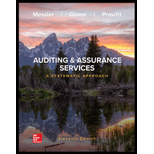
EBK AUDITING & ASSURANCE SERVICES: A SY
11th Edition
ISBN: 9781260687668
Author: Jr
Publisher: MCGRAW-HILL LEARNING SOLN.(CC)
expand_more
expand_more
format_list_bulleted
Question
Chapter 3, Problem 3.24MCQ
To determine
Concept Introduction:
A tolerable misstatement is the level or amount of a misstatement which can be ignored by the auditor. There is an opposite relation between the
To choose: The correct meaning of tolerable misstatement.
Expert Solution & Answer
Want to see the full answer?
Check out a sample textbook solution
Students have asked these similar questions
Need answer.
Solve plz now
Precious metal qn solve .
Chapter 3 Solutions
EBK AUDITING & ASSURANCE SERVICES: A SY
Ch. 3 - Prob. 3.1RQCh. 3 - Prob. 3.2RQCh. 3 - Prob. 3.3RQCh. 3 - Prob. 3.4RQCh. 3 - Prob. 3.5RQCh. 3 - Prob. 3.6RQCh. 3 - Prob. 3.7RQCh. 3 - Prob. 3.8RQCh. 3 - Prob. 3.9RQCh. 3 - Prob. 3.10RQ
Ch. 3 - Prob. 3.11RQCh. 3 - Prob. 3.12RQCh. 3 - Prob. 3.13RQCh. 3 - Prob. 3.14RQCh. 3 - Prob. 3.15RQCh. 3 - Prob. 3.16MCQCh. 3 - Prob. 3.17MCQCh. 3 - Prob. 3.18MCQCh. 3 - Prob. 3.19MCQCh. 3 - Prob. 3.20MCQCh. 3 - Prob. 3.21MCQCh. 3 - Prob. 3.22MCQCh. 3 - Prob. 3.23MCQCh. 3 - Prob. 3.24MCQCh. 3 - Prob. 3.25MCQCh. 3 - Prob. 3.26PCh. 3 - Prob. 3.27PCh. 3 - Prob. 3.28PCh. 3 - Prob. 3.29PCh. 3 - Prob. 3.30PCh. 3 - Prob. 3.31PCh. 3 - Prob. 3.32P
Knowledge Booster
Similar questions
arrow_back_ios
SEE MORE QUESTIONS
arrow_forward_ios
Recommended textbooks for you
 Auditing: A Risk Based-Approach (MindTap Course L...AccountingISBN:9781337619455Author:Karla M Johnstone, Audrey A. Gramling, Larry E. RittenbergPublisher:Cengage Learning
Auditing: A Risk Based-Approach (MindTap Course L...AccountingISBN:9781337619455Author:Karla M Johnstone, Audrey A. Gramling, Larry E. RittenbergPublisher:Cengage Learning Auditing: A Risk Based-Approach to Conducting a Q...AccountingISBN:9781305080577Author:Karla M Johnstone, Audrey A. Gramling, Larry E. RittenbergPublisher:South-Western College Pub
Auditing: A Risk Based-Approach to Conducting a Q...AccountingISBN:9781305080577Author:Karla M Johnstone, Audrey A. Gramling, Larry E. RittenbergPublisher:South-Western College Pub

Auditing: A Risk Based-Approach (MindTap Course L...
Accounting
ISBN:9781337619455
Author:Karla M Johnstone, Audrey A. Gramling, Larry E. Rittenberg
Publisher:Cengage Learning

Auditing: A Risk Based-Approach to Conducting a Q...
Accounting
ISBN:9781305080577
Author:Karla M Johnstone, Audrey A. Gramling, Larry E. Rittenberg
Publisher:South-Western College Pub
